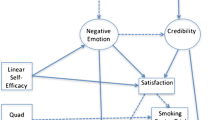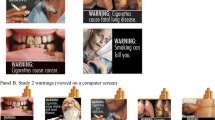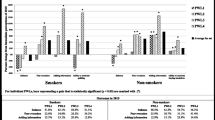Abstract
Young adults are influenced by cigarette package marketing. Pictorial warning labels are a recommended intervention. Evidence demonstrates pictorial warnings impact negative emotion, risk perceptions, and motivation to quit smoking, but there is limited research on their effects over time. This study analyzes data from a randomized trial of young adult smokers (N = 229) exposed to a pictorial or text-only cigarette warning. We assessed changes in fear, anger, risk perceptions, and motivation to quit smoking after 4 weeks using latent change score modeling and over 3 months using latent growth modeling. Latent change results showed exposure was associated with increases in fear, anger, and motivation to quit after 4 weeks. Latent growth showed exposure was associated with increases in motivation to quit smoking over 3 months, but not other outcomes. Findings suggest pictorial warning labels produce an emotional response and increase motivation to quit among young adult smokers.
Similar content being viewed by others
Availability of data and material
Data and materials available upon request.
Code availability
Custom code available upon request.
References
Berg, C. J., Haardörfer, R., Vu, M., Getachew, B., Lloyd, S. A., Lanier, A., Childs, D., Sandridge, Y., Bierhoff, J., Li, J., Dossantos, E., & Windle, M. (2018). Cigarette use trajectories in young adults: Analyses of predictors across system levels. Drug and Alcohol Dependence, 188, 281–287. https://doi.org/10.1016/j.drugalcdep.2018.03.055
Berkman, E. T., Dickenson, J., Falk, E. B., & Lieberman, M. D. (2011). Using SMS text messaging to assess moderators of smoking reduction: Validating a new tool for ecological measurement of health behaviors. Health Psychology: Official Journal of the Division of Health Psychology, American Psychological Association, 30(2), 186–194. https://doi.org/10.1037/a0022201
Brewer, N. T., Hall, M. G., Noar, S. M., Parada, H., Stein-Seroussi, A., Bach, L. E., Hanley, S., & Ribisl, K. M. (2016). Effect of pictorial cigarette pack warnings on changes in smoking behavior: A randomized clinical trial. JAMA Internal Medicine, 176(7), 905–912. https://doi.org/10.1001/jamainternmed.2016.2621
Brewer, N. T., Parada, H., Hall, M. G., Boynton, M. H., Noar, S. M., & Ribisl, K. M. (2019). Understanding Why Pictorial Cigarette Pack Warnings Increase Quit Attempts. Annals of Behavioral Medicine: A Publication of the Society of Behavioral Medicine, 53(3), 232–243. https://doi.org/10.1093/abm/kay032
Brook, D. W., Brook, J. S., Zhang, C., Whiteman, M., Cohen, P., & Finch, S. J. (2008). Developmental trajectories of cigarette smoking from adolescence to the early thirties: Personality and behavioral risk factors. Nicotine & Tobacco Research: Official Journal of the Society for Research on Nicotine and Tobacco, 10(8), 1283–1291. https://doi.org/10.1080/14622200802238993
Brown, T. A. (2015). Confirmatory factor analysis for applied research (2nd ed.). New York: Guilford Press.
Centers for Disease Control and Prevention. (2014). Best Practices for Comprehensive Tobacco Control Programs—2014. Atlanta: U.S. Department of Health and Human Services, Centers for Disease Control and Prevention, National Center for Chronic Disease Prevention and Health Promotion, Office on Smoking and Health.
Chowdhury, P., Balluz, L., Town, M., Chowdhury, F. M., Bartolis, W., Garvin, W., Akcin, H., Greenlund, K. J., Giles, W., & Centers for Disease Control and Prevention (CDC). (2010). Surveillance of certain health behaviors and conditions among states and selected local areas—Behavioral Risk Factor Surveillance System, United States, 2007. Morbidity and Mortality Weekly Report. Surveillance Summaries (Washington, D.C.: 2002), 59(1), 1–220.
Cornelius, M., Wang, T., Jamal, A., Loretan, C., & Neff, L. (2020). Tobacco Product Use Among Adults—United States, 2019. MMWR. Morbidity and Mortality Weekly Report, 69(46), 1736.
Creamer, M. R., Wang, T. W., Babb, S., Cullen, K. A., Day, H., Willis, G., Jamal, A., & Neff, L. (2019). Tobacco product use and cessation indicators among adults—United States, 2018. MMWR. Morbidity and Mortality Weekly Report, 68(45), 1013–1019. https://doi.org/10.15585/mmwr.mm6845a2
Evans, A. T., Peters, E., Strasser, A. A., Emery, L. F., Sheerin, K. M., & Romer, D. (2015). Graphic warning labels elicit affective and thoughtful responses from smokers: Results of a randomized clinical trial. PLoS ONE, 10(12), e0142879. https://doi.org/10.1371/journal.pone.0142879
Ferrer, R. A., Klein, W. M. P., Persoskie, A., Avishai-Yitshak, A., & Sheeran, P. (2016). The tripartite model of risk perception (TRIRISK): Distinguishing deliberative, affective, and experiential components of perceived risk. Annals of Behavioral Medicine: A Publication of the Society of Behavioral Medicine, 50(5), 653–663. https://doi.org/10.1007/s12160-016-9790-z
Fishbein, M., & Ajzen, I. (2010). Predicting and changing behavior: The Reasoned Action Approach. Psychology Press.
Food and Drug Administration. (2011). Required warnings for cigarette packages and advertisement. https://www.federalregister.gov/documents/2011/06/22/2011-15337/required-warnings-for-cigarette-packages-and-advertisements
Food and Drug Administration. (2020). Tobacco Products; Required Warnings for Cigarette Packages and Advertisements. Federal Register. https://www.federalregister.gov/documents/2020/03/18/2020-05223/tobacco-products-required-warnings-for-cigarette-packages-and-advertisements
Food and Drug Administration. (2021). Tobacco Products; Required Warnings for Cigarette Packages and Advertisements; Delayed Effective Date. Federal Register. https://www.federalregister.gov/documents/2021/01/15/2021-00703/tobacco-products-required-warnings-for-cigarette-packages-and-advertisements-delayed-effective-date
Geiser, C. (2013). Data analysis with Mplus. Guilford Press.
Hall, M. G., Sheeran, P., Noar, S. M., Boynton, M. H., Ribisl, K. M., Parada, H., Johnson, T. O., & Brewer, N. T. (2018). Negative affect, message reactance and perceived risk: How do pictorial cigarette pack warnings change quit intentions? Tobacco Control, 27(e2), e136–e142. https://doi.org/10.1136/tobaccocontrol-2017-053972
Hammond, D. (2011). Health warning messages on tobacco products: A review. Tobacco Control, 20(5), 327–337. https://doi.org/10.1136/tc.2010.037630
Howe, G. W., Beach, S. R. H., Brody, G. H., & Wyman, P. A. (2015). Translating genetic research into preventive intervention: The baseline target moderated mediator design. Frontiers in Psychology, 6, 1911. https://doi.org/10.3389/fpsyg.2015.01911
Howe, G. W., Cimporescu, M., Seltzer, R., Neiderhiser, J. M., Moreno, F., & Weihs, K. (2017). Combining stress exposure and stress generation: Does neuroticism alter the dynamic interplay of stress, depression, and anxiety following job loss? Journal of Personality, 85(4), 553–564. https://doi.org/10.1111/jopy.12260
Jamal, A., Homa, D. M., O’Connor, E., Babb, S. D., Caraballo, R. S., Singh, T., Hu, S. S., & King, B. A. (2015). Current cigarette smoking among adults—United States, 2005–2014. MMWR. Morbidity and Mortality Weekly Report, 64(44), 1233–1240. https://doi.org/10.15585/mmwr.mm6444a2
Janz, N. K., & Becker, M. H. (1984). The health belief model: A decade later. Health Education Quarterly, 11(1), 1–47. https://doi.org/10.1177/109019818401100101
Kaufman, A. R., Persoskie, A., Twesten, J., & Bromberg, J. (2020). A review of risk perception measurement in tobacco control research. Tobacco Control, 29(Suppl 1), s50–s58. https://doi.org/10.1136/tobaccocontrol-2017-054005
Kaufman, A. R., Twesten, J. E., Suls, J., McCaul, K. D., Ostroff, J. S., Ferrer, R. A., Brewer, N. T., Cameron, L. D., Halpern-Felsher, B., Hay, J. L., Park, E. R., Peters, E., Strong, D. R., Waters, E. A., Weinstein, N. D., Windschitl, P. D., & Klein, W. M. P. (2019). Measuring cigarette smoking risk perceptions. Nicotine & Tobacco Research: Official Journal of the Society for Research on Nicotine and Tobacco. https://doi.org/10.1093/ntr/ntz213
Kees, J., Burton, S., Andrews, J. C., & Kozup, J. (2010). Understanding how graphic pictorial warnings work on cigarette packaging. Journal of Public Policy & Marketing, 29(2), 265–276. https://doi.org/10.1509/jppm.29.2.265
Levy, D. T., Mays, D., Yuan, Z., Hammond, D., & Thrasher, J. F. (2017). Public health benefits from pictorial health warnings on US cigarette packs: A SimSmoke simulation. Tobacco Control, 26(6), 649–655. https://doi.org/10.1136/tobaccocontrol-2016-053087
Lipkus, I. M., Eissenberg, T., Schwartz-Bloom, R. D., Prokhorov, A. V., & Levy, J. (2011). Affecting perceptions of harm and addiction among college waterpipe tobacco smokers. Nicotine & Tobacco Research: Official Journal of the Society for Research on Nicotine and Tobacco, 13(7), 599–610. https://doi.org/10.1093/ntr/ntr049
Lochbuehler, K., Wileyto, E. P., Mercincavage, M., Souprountchouk, V., Burdge, J. Z., Tang, K. Z., Cappella, J. N., & Strasser, A. A. (2019). Temporal effects of message congruency on attention to and recall of pictorial health warning labels on cigarette packages. Nicotine & Tobacco Research: Official Journal of the Society for Research on Nicotine and Tobacco, 21(7), 879–886. https://doi.org/10.1093/ntr/nty124
Mays, D., Murphy, S. E., Johnson, A. C., Kraemer, J. D., & Tercyak, K. P. (2014). A pilot study of research methods for determining the impact of pictorial cigarette warning labels among smokers. Tobacco Induced Diseases, 12(1), 16. https://doi.org/10.1186/1617-9625-12-16
Mays, D., Turner, M. M., Zhao, X., Evans, W. D., Luta, G., & Tercyak, K. P. (2015). Framing pictorial cigarette warning labels to motivate young smokers to quit. Nicotine & Tobacco Research: Official Journal of the Society for Research on Nicotine and Tobacco, 17(7), 769–775. https://doi.org/10.1093/ntr/ntu164
McArdle, J. J. (2009). Latent variable modeling of differences and changes with longitudinal data. Annual Review of Psychology, 60, 577–605. https://doi.org/10.1146/annurev.psych.60.110707.163612
Muthén, B., & Asparouhov, T. (2009). Beyond multilevel regression modeling: Multilevel analysis in a general latent variable framework. In The handbook of advanced multilevel analysis (In J. Hox, J. K. Roberts (Eds.)). https://www.statmodel.com/download/multilevelVersion2.pdf
Muthén, L. K., & Muthén, B. (2010). Growth modeling with latent variables using Mplus: Introductory and intermediate growth models. https://www.statmodel.com/download/Topic%203.pdf
Noar, S. M., Hall, M. G., Francis, D. B., Ribisl, K. M., Pepper, J. K., & Brewer, N. T. (2016). Pictorial cigarette pack warnings: A meta-analysis of experimental studies. Tobacco Control, 25(3), 341–354. https://doi.org/10.1136/tobaccocontrol-2014-051978
Parada, H., Hall, M. G., Boynton, M. H., & Brewer, N. T. (2018). Trajectories of responses to pictorial cigarette pack warnings. Nicotine & Tobacco Research: Official Journal of the Society for Research on Nicotine and Tobacco, 20(7), 876–881. https://doi.org/10.1093/ntr/ntx182
Public Health and Tobacco Policy Center. (n.d.). FDA graphic warnings. https://tobaccopolicycenter.org/tobacco-control/tobacco-litigation/fda-graphic-warnings/
Public Health Law Center. (2011). R.J. Reynolds Tobacco Co. V. U.S. Food & Drug Administration (2011). https://www.publichealthlawcenter.org/content/rj-reynolds-tobacco-co-v-us-food-drug-administration
Reyna, V. F., & Rivers, S. E. (2008). Current Theories of Risk and Rational Decision Making. Developmental Review: DR, 28(1), 1–11. https://doi.org/10.1016/j.dr.2008.01.002
Schneider, S., Gadinger, M., & Fischer, A. (2012). Does the effect go up in smoke? A randomized controlled trial of pictorial warnings on cigarette packaging. Patient Education and Counseling, 86(1), 77–83. https://doi.org/10.1016/j.pec.2011.03.005
Skurka, C., Kalaji, M., Dorf, M. C., Kemp, D., Greiner Safi, A., Byrne, S., Mathios, A. D., Avery, R. J., & Niederdeppe, J. (2019). Independent or synergistic? Effects of varying size and using pictorial images in tobacco health warning labels. Drug and Alcohol Dependence, 198, 87–94. https://doi.org/10.1016/j.drugalcdep.2019.01.034
Slovic, P. (1987). Perception of risk. Science (new York NY), 236(4799), 280–285. https://doi.org/10.1126/science.3563507
Song, A. V., & Ling, P. M. (2011). Social smoking among young adults: Investigation of intentions and attempts to quit. American Journal of Public Health, 101(7), 1291–1296. https://doi.org/10.2105/AJPH.2010.300012
Song, A. V., Ling, P. M., Neilands, T. B., & Glantz, S. A. (2007). Smoking in movies and increased smoking among young adults. American Journal of Preventive Medicine, 33(5), 396–403. https://doi.org/10.1016/j.amepre.2007.07.026
Thrasher, J. F., Brewer, N. T., Niederdeppe, J., Peters, E., Strasser, A. A., Grana, R., & Kaufman, A. R. (2019). Advancing Tobacco Product Warning Labels Research Methods and Theory: A Summary of a Grantee Meeting Held by the US National Cancer Institute. Nicotine & Tobacco Research: Official Journal of the Society for Research on Nicotine and Tobacco, 21(7), 855–862. https://doi.org/10.1093/ntr/nty017
U.S. Department of Health and Human Services. (2012). Preventing Tobacco Use Among Youth and Young Adults: A Report of the Surgeon General. Atlanta, GA: U.S. Department of Health and Human Services, Centers for Disease Control and Prevention, National Center for Chronic Disease Prevention and Health Promotion, Office on Smoking and Health.
U.S. Department of Health and Human Services. (2014). The Health Consequences of Smoking—50 Years of Progress: A Report of the Surgeon General. Atlanta, GA: U.S. Department of Health and Human Services, Centers for Disease Control and Prevention, National Center for Chronic Disease Prevention and Health Promotion, Office on Smoking and Health.
van Mourik, D.-J.A., Nagelhout, G. E., de Vries, H., van den Putte, B., Cummings, K. M., Borland, R., Fong, G. T., & Willemsen, M. C. (2020). Quasi-experimentally examining the impact of introducing tobacco pictorial health warnings: Findings from the International Tobacco Control (ITC) 4C and Netherlands surveys in the Netherlands, Australia, Canada, United Kingdom, and the United States. Drug and Alcohol Dependence, 207, 107818. https://doi.org/10.1016/j.drugalcdep.2019.107818
Villanti, A. C., Niaura, R. S., Abrams, D. B., & Mermelstein, R. (2019). Preventing smoking progression in young adults: The concept of prevescalation. Prevention Science: THe Official Journal of the Society for Prevention Research, 20(3), 377–384. https://doi.org/10.1007/s11121-018-0880-y
Wong, N. C. H., & Cappella, J. N. (2009). Antismoking threat and efficacy appeals: Effects on smoking cessation intentions for smokers with low and high readiness to quit. Journal of Applied Communication Research: JACR, 37(1), 1–20. https://doi.org/10.1080/00909880802593928
World Health Organization Framework Convention on Tobacco Control. (2003). Framework convention on tobacco control (WHO Library Cataloguing, ISBN: 9789241591010).
Acknowledgements
The authors would like to acknowledge George W. Howe, PhD and Andrea C. Villanti, PhD, MPH for their feedback on earlier versions of the manuscript. The authors would also like to acknowledge study participants and research staff for their efforts in data collection and follow-up procedures.
Funding
Research reported in this publication was supported by the National Cancer Institute (NCI) of the National Institutes of Health (NIH) under Award Number F31CA239567. Research reported in this publication was also supported by the NCI of the NIH and the U.S. Food and Drug Administration (FDA) Center for Tobacco Products under Award Number K07CA172217 and U54CA229973. The content is solely the responsibility of the authors and does not necessarily represent the official views of the NIH or the FDA.
Author information
Authors and Affiliations
Contributions
ACJ led the current study conception and design with input from DM, MMT, and SJS. DM led the parent study conception, design, and data collection. ACJ conducted formal data analyses with support from SJS. ACJ wrote the first draft of the manuscript. All authors read the manuscript, provided input, and approved the final manuscript. ACJ, DM, and AAS led funding acquisition.
Corresponding author
Ethics declarations
Conflict of interest
The authors have no conflicts of interest to declare.
Ethical approval
The study complies with ethical standards for the protection of human subjects. All procedures performed in studies involving human participants were in accordance with the ethical standards of the institutional and/or national research committee and with the 1964 Helsinki Declaration and its later amendments or comparable ethical standards. The study was approved by the Georgetown University Institutional Review Board. The study is registered as NCT03446170 at clinicaltrials.gov.
Consent to participate
Written informed consent was obtained from all individual participants included in the study.
Consent for publication
Not applicable.
Additional information
Publisher's Note
Springer Nature remains neutral with regard to jurisdictional claims in published maps and institutional affiliations.
Rights and permissions
About this article
Cite this article
Johnson, A.C., Simmens, S.J., Turner, M.M. et al. Longitudinal effects of cigarette pictorial warning labels among young adults. J Behav Med 45, 124–132 (2022). https://doi.org/10.1007/s10865-021-00258-2
Received:
Accepted:
Published:
Issue Date:
DOI: https://doi.org/10.1007/s10865-021-00258-2




